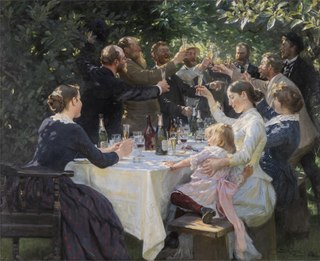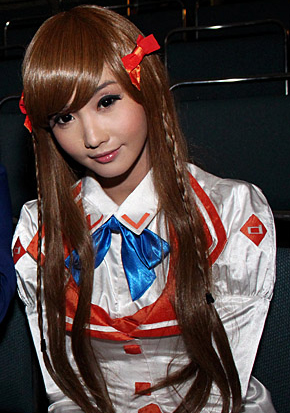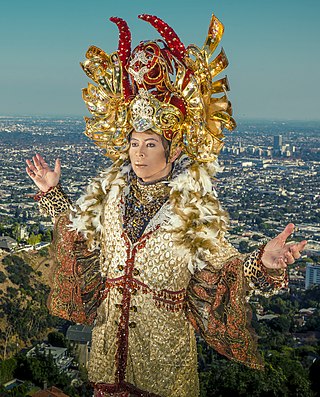Costume is the distinctive style of dress or cosmetic of an individual or group that reflects class, gender, profession, ethnicity, nationality, activity or epoch. In short costume is a cultural visual of the people.

A party is a gathering of people who have been invited by a host for the purposes of socializing, conversation, recreation, or as part of a festival or other commemoration or celebration of a special occasion. A party will often feature food and beverages, and often conversation, music, dancing, or other forms of entertainment.
Worldcon, or more formally the World Science Fiction Convention, the annual convention of the World Science Fiction Society (WSFS), is a science fiction convention. It has been held each year since 1939. The members of each Worldcon are the members of WSFS, and vote both to select the site of the Worldcon two years later, and to select the winners of the annual Hugo Awards, which are presented at each convention.

A masquerade ball is an special kind of formal ball which many participants attend in costume wearing masks. Less formal "costume parties" may be a descendant of this tradition. A masquerade ball usually encompasses music and dancing. These nighttime events are used for entertainment and celebrations.

Cosplay, a portmanteau of "costume play", is an activity and performance art in which participants called cosplayers wear costumes and fashion accessories to represent a specific character. Cosplayers often interact to create a subculture, and a broader use of the term "cosplay" applies to any costumed role-playing in venues apart from the stage. Any entity that lends itself to dramatic interpretation may be taken up as a subject. Favorite sources include anime, cartoons, comic books, manga, television series, rock music performances, video games and in some cases original characters. The term is composed of the two aforementioned counterparts – costume and role play.

A science fiction convention is a gathering of fans of science fiction. Historically, science fiction conventions had focused primarily on literature, but the purview of many extends to such other avenues of expression as films, television, comics, animation, and games. The format can vary but will tend to have a few similar features such as a guest of honour, discussion panels, readings and large special events such as opening/closing ceremonies and some form of party or entertainment. Science fiction conventions started off primarily in the UK and US but have now spread further and several countries have their own individual conventions as well as playing host to rotating international conventions.

A fan convention is an event in which fans of a particular topic gather to participate and hold programs and other events, and to meet experts, famous personalities, and each other. Some also incorporate commercial activity. The term dates back to at least 1942.
The 1st World Science Fiction Convention (Worldcon) was held on 2–4 July 1939 in the Caravan Hall in New York City, United States, in conjunction with the New York World's Fair, which was themed as "The World of Tomorrow". It was later retroactively named "NyCon I" by Forrest J Ackerman.
The 2nd World Science Fiction Convention (Worldcon), also known as Chicon I, was held on 1–2 September 1940 at the Hotel Chicagoan in Chicago, Illinois, United States.
MomoCon is a fan convention held in March or May in Atlanta, Georgia.

Horror conventions are gatherings of the community of fans of various forms of horror including horror cinema, goth lifestyle, and occasionally science fiction and fantasy. Historically the focus has been on the cinematic form rather than literature and art, but this has broadened to include all forms in recent years. People in attendance at a horror convention are traditionally known as members of the convention; invited celebrities including film directors and stars are commonly known as guests of the convention, though many professionals including directors will simply attend as members.

Otakuthon is Canada's largest anime convention promoting Japanese animation (anime), Japanese graphic novels (manga), related gaming and Japanese pop-culture. It is held annually for 3 days in downtown Montreal during a weekend in August. It is a non-profit, fan-run anime convention that was initiated by Concordia University's anime club, named Otaku Anime of Concordia University. The name "Otakuthon" is a portmanteau of the Japanese word "otaku" and "marathon". Otakuthon strives to be a bilingual event, having programming, the masquerade and the program book in both official languages. The first edition of Otakuthon was held in 2006 in mid-June, but later moved to early-mid August / late July from 2007 onward. The most recent edition, Otakuthon 2023, was held on August 11–13, 2023 at the Palais des congrès de Montréal. As of 2023, Otakuthon surpassed Toronto's Anime North to become Canada's largest Anime convention.

Ohayocon is a three-day anime convention typically held during January in Columbus, Ohio, at the Hyatt Regency Columbus and the Greater Columbus Convention Center. Ohayocon's name is derived from the similarity between "Ohio", the convention's location, and Ohayou (おはよう), which means "good morning" in Japanese.

Anime Milwaukee (AMKE) is an annual three-day anime convention held during February at the Wisconsin Center and Hilton Milwaukee City Center in Milwaukee, Wisconsin. It is Wisconsin's largest anime convention.

Alodía Almira Arraiza Gosiengfiao-Quimbo is a Filipino cosplayer, model, TV presenter, singer, vlogger, actress and co-founder of Tier One Entertainment. She is also known as Senpai Alodia of the Philippines. As a celebrity endorser, she is one of the ambassadors and VJ for Animax Asia known as the "Ani-mates" and co-host of ABS-CBN's prank show Laugh Out Loud. She has been featured in various magazines, newspapers and TV shows locally and abroad. She appeared on the Filipino FHM 100 Sexiest Women poll, ranking No. 1 in 2009, No. 2 in 2010 and No. 3 in 2012; she posed as the cover girl for that magazine on its July 2013 issue. She was named by DOS Magazine as one of the Most Influential Women in the Philippines.

FANdom Con was an annual three-day multigenre convention held during November at the Emerald Coast Convention Center in Fort Walton Beach, Florida.
Nadeshicon is a Japanese culture / anime convention held in April in Quebec City, Quebec, Canada at the Centre des congrès de Québec convention center since 2019, and initially at Université Laval in the Alphonse-Desjardins and Maurice-Pollack buildings from 2011 to 2018. The convention is run and organized by Club Animé Québec(CAQ), an extracurricular student association and nonprofit organization. It is recognized as one of the main Japanese cultural events in the city. Like most other anime conventions, Nadeshicon's events, attractions and activities include a Dealer's Room and an Artists Alley, anime screenings, panels and workshops, AMV contests, game shows, cosplay events, and video games stations. A part of the convention is also dedicated to cultural Japanese activities.
Myrtle Rebecca Smith Gray Nolan, known to science fiction history as Morojo or sometimes Myrtle R Douglas, was a science fiction fan, fanzine publisher, and cosplay pioneer from Los Angeles.
The Labyrinth of Jareth Masquerade Ball, shortened to LOJ or simply known as the Labyrinth Masquerade Ball, is an annual masquerade ball and cosplay event in Los Angeles, California. The ball was first held in 1997.

Bobby Love is an American fashion designer known primarily for creating designs in the genre known as fantasy couture. Love has identified Salvador Dalí, Alphonse Mucha, and the Art Deco master Erté as major inspirations for his style, and the mechanical parrots which appear in his sets are named "Erté" in his honor.















